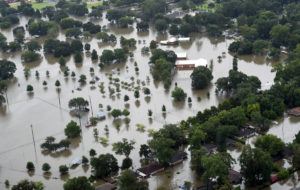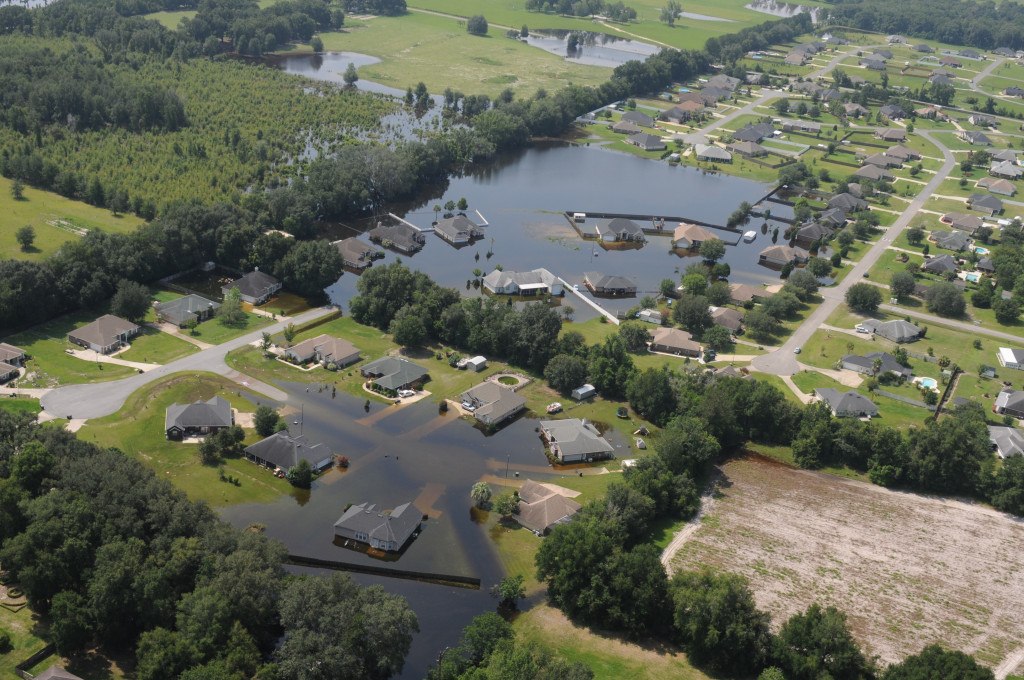Floodwaters rose about 15 inches (40 centimeters) into Danielle Rees’ home in September when Hurricane Florence drenched this tidewater city on the Pamlico River and overwhelmed a local creek and marshland. The first floor was a sopping mess of gritty, swampy water in three bedrooms, a bathroom and a laundry.
“It’s part of living close to the river, and Washington is really low land,” said Rees, a graphic designer who grew up in the city.
But she anticipates her $2,000-a-year policy through the taxpayer-subsidized National Flood Insurance Program will help her rebuild the home about a quarter-mile from the river, just as it did in 2011 after Hurricane Irene – and as it did, under previous ownership, after floods in 1996, 1998 and 1999, according to her property history provided by the Federal Emergency Management Agency. The program has done something similar, over and over, for others.
Records at FEMA, which operates the program, show that nearly 37,000 properties from the Carolinas to California have repeatedly flooded and been rebuilt – some dozens of times – with help from a federal insurance program that is, itself, financially underwater. About 18,000 of those are currently covered by policies, and 15,000 of those haven’t taken voluntary steps to reduce the risk of future damage to their property, FEMA said this week.
The National Flood Insurance Program was $20 billion in the red before the start of the current hurricane season, even after Congress last year wrote off an additional $16 billion. The program must be reauthorized by Congress this month.

The repeatedly flooded properties cost nearly $7.4 billion in claims before the start of the current hurricane season.
Rees’ home isn’t included on the official “severe repetitive loss” list because the 1996 and 1998 hurricanes didn’t cause damage exceeding $5,000. It takes at least four of those $5,000-plus occurrences to put properties on the list.
Last year was the 40-year-old flood program’s second-worst, with more than $10 billion in claims, following hits from Hurricanes Harvey in Texas and Maria in Puerto Rico. Annual losses have risen and fallen with the weather since a record in 2005, when Hurricane Katrina swamped the Gulf Coast and triggered more than $16 billion in payouts.
Some critics say the situation will only worsen as global climate change generates more
The properties thatextreme weather and raises ocean levels.
have suffered severe and repetitive losses “are the canary in the coal mine for the millions of properties in the U.S. that are going to be in the exact same situation in future decades,” said Rob Moore, water and climate director at the Natural Resources Defense Council.
The environmental group favors FEMA giving homeowners more financial help to move to higher ground rather than rebuilding flooded properties over and over.
With more than 5 million policies, the nation’s main source of flood insurance generated $4.3 billion in annual premiums in 2016 and paid claims of at least $3.7 billion, the Congressional Budget Office reported last year. The median cost of a year of residential coverage was $520 that year.
The federal coverage is available to homeowners, renters and business owners if their community adopts required flood-plain management measures, such as elevating buildings and preventing construction on land where water drains away.
As of May, the 10 states with the most repeatedly flooded insured properties follow the Gulf and East Coasts as far north as New York, but also include Missouri along the Mississippi River, according to FEMA data provided to the Natural Resources Defense Council after the group said it sued the agency three years ago. The group gave the data to The Associated Press.
Louisiana has had the most repeatedly flooded properties over the past 40 years, with 23 percent of the total, the FEMA records show. That includes two single-family homes in Slidell and New Orleans that have each been compensated for flood losses two dozen times.
When Hurricane Florence poured up to 30 inches (75 centimeters) of rain onto eastern North Carolina in September, towns along rivers and sounds were swamped again. They included Belhaven and Washington, which lead the state in the number of severe, repeatedly flooded properties.
Rees learned in late October that she can expect some extra help – $30,000 through a flood mitigation plan for repetitively damaged, insured properties. She hopes her insurance payout and her own savings will help her pay to add a bedroom on stilts to her existing home and move her living spaces off the ground floor.
“I’m trying to hurricane-proof my house,” Rees said. “Next time, I know I’m going to have water in it.”
With more than 3.8 million households altogether, North Carolina has only about 134,000 flood insurance policies. The state has 1,132 structures from Carolina Beach to Charlotte on the “severe repetitive loss” list.
Eighty-two percent of the flooded properties that have been bailed out repeatedly are single-family homes, said Moore. Those homes were worth an average of $115,000, but have incurred $150,000 in damage claims, he said.
“Many people that find themselves in a situation of living in a repeatedly flooded house would like nothing more than to never file another flood insurance damage claim ever again. But the only assistance that’s readily available to them after a flood is to rebuild if they have flood insurance. So they’re kind of trapped,” Moore said.
The flood program and its ability to borrow money expire at the end of this month as hurricane season ends, unless Congress approves another extension. FEMA last year urged Congress to consider limiting payouts that far exceed a property’s total value. Efforts to reform the program, including how it treats repeatedly flooded properties, are again on the table.
But partisanship and the opposition of Louisiana’s two Republican senators mean the likeliest result is a short-term renewal of the insurance program, said R.J. Lehmann, insurance policy director at the free-market think tank R Street in Washington.
“There won’t be really any reforms at all this year,” he said.
Was this article valuable?
Here are more articles you may enjoy.


 Cat Bonds Linked to Wildfires Lose ‘Once Untouchable’ Status
Cat Bonds Linked to Wildfires Lose ‘Once Untouchable’ Status  Wells Fargo Sued by Ex-Manager Who Said Bank Faked Diversity
Wells Fargo Sued by Ex-Manager Who Said Bank Faked Diversity  Apollo Expands Asset-Level Risk Reviews to Reflect Impact of Extreme Weather
Apollo Expands Asset-Level Risk Reviews to Reflect Impact of Extreme Weather  ‘Door Knocker’ Roofers Were Everywhere. NC Farm Bureau Saw an Opportunity
‘Door Knocker’ Roofers Were Everywhere. NC Farm Bureau Saw an Opportunity 